1.The HERO Stones. 2.The Sati Stones. 3.The Gadhegal Stone (Ass Curse Stone)
The Hero Stones (Veergal) – Historic 1000 Year old हेमाडपंती मंदिर-
A Hero Stone (Veergal in Marathi, Veeragallu in Kannada or Naṭukal in Tamil) is essentially a memorial commemorating the honorable death of a hero, usually in battle.Most of these stones were erected between the 3rd century BCE and the 18th century CE, and can be found all over India, although the higher concentration of them appears to occur in south India. It is thought that Karnataka alone has over 2,500 examples of these memorial stones with their origins dating back to the Iron Age.
वीर दगड (मराठीमध्ये वीरगल, कन्नडमध्ये वीरगल्लू किंवा तमिळमध्ये नटुकळ) हा मूलतः युद्धात होणाऱ्या वीराच्या सन्माननीय मृत्युचे स्मरण करणारा स्मारक आहे. यातील बहुतेक दगड इ.स.पू. ३रे शतक आणि इ.स. १८ व्या शतकाच्या दरम्यान उभारण्यात आले होते आणि ते संपूर्ण भारतात आढळतात, जरी त्यापैकी जास्त प्रमाणात दक्षिण भारतात आढळतात. असे मानले जाते की एकट्या कर्नाटकात या स्मारक दगडांची २,५०० हून अधिक उदाहरणे आहेत ज्यांचे मूळ लोहयुगातील आहे.
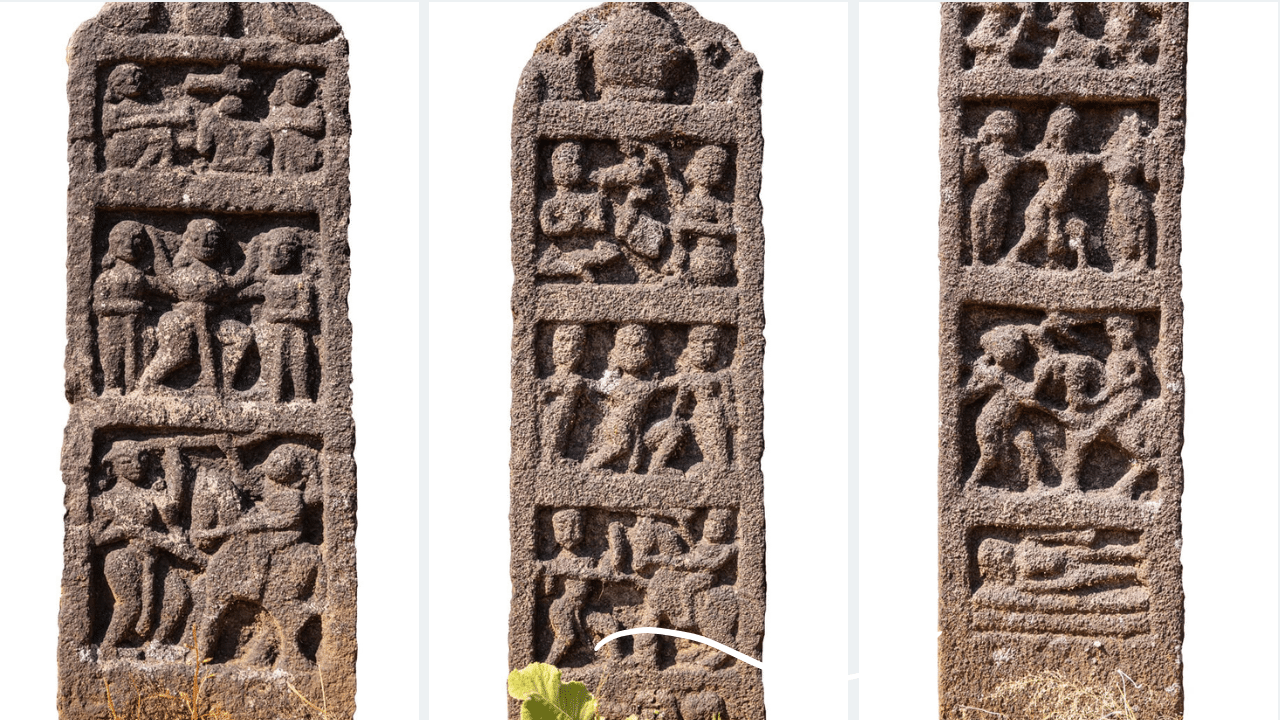

A hero stone was usually divided into three panels, although this was no fixed rule and depending on the event four or five panels can also occur. The carvings appear on one side of the upright stone, in the case of the more typical and simplistic three panel layout, the narrative is as follows :
एक वीर दगड सहसा तीन पॅनलमध्ये विभागला जात असे, जरी हा निश्चित नियम नव्हता आणि घटनेनुसार चार किंवा पाच पॅनल देखील होऊ शकतात. उभ्या दगडाच्या एका बाजूला कोरीवकाम दिसून येते, अधिक सामान्य आणि सोप्या तीन पॅनल लेआउटच्या बाबतीत, कथा खालीलप्रमाणे आहे:

The subject worshiping a deity, most commonly a Shiva linga (sometimes a Nandi), accompanied by an attendant or priest.
Depicts the hero flanked by nymphs (apsaras), sometimes being lifted up to the heavens. Occasionally the hero is seated in a palanquin.
Depicts how the hero died, so battle scenes are often shown, but on occasions you do come across something a little different.
एखाद्या देवतेची, बहुतेकदा शिवलिंगाची (कधीकधी नंदीची) पूजा करणारा कर्ता, सेवक किंवा पुजारी सोबत असतो.
नायकाला अप्सरा (अप्सरा) ने वेढलेले दाखवले आहे, कधीकधी तो स्वर्गात उचलला जातो. कधीकधी नायक पालखीत बसलेला असतो.
नायकाचा मृत्यू कसा झाला हे दाखवले आहे, म्हणून युद्धाची दृश्ये अनेकदा दाखवली जातात, परंतु कधीकधी तुम्हाला काहीतरी वेगळेच आढळते.
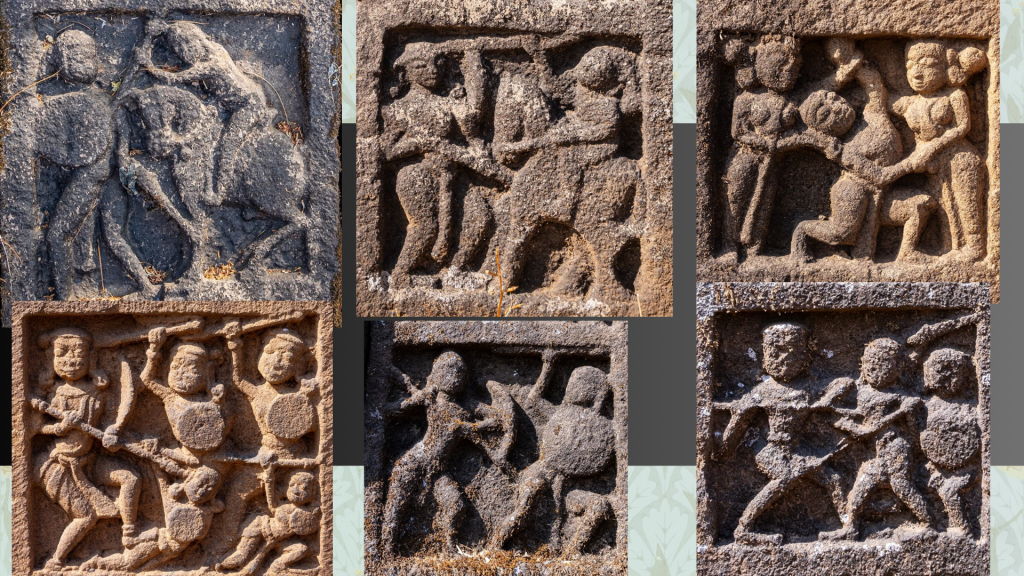
Animated battle scenes depicting how our heroes died in battle in Umbardi.उम्बार्डी येथील युद्धात आपले वीर कसे मरण पावले हे दर्शविणारी अॅनिमेटेड युद्ध दृश्ये
The nature of the hero’s death sometimes necessitates the need for an additional lower panel to add further clarity to the story of his demise. So a battle scene may be followed by a scene showing the hero lying dead next to cattle, indicating that he was protecting his herd. In the case of the hero stones at Umbardi, it would appear that here they all died in arm to arm combat, and the subtle variations in the narrative are absent.
नायकाच्या मृत्यूचे स्वरूप पाहून कधीकधी त्याच्या मृत्युच्या कथेत अधिक स्पष्टता आणण्यासाठी एका अतिरिक्त खालच्या पॅनेलची आवश्यकता भासते. म्हणून युद्धाच्या दृश्यानंतर नायकाला गुराढोरांजवळ मृतावस्थेत पडलेले दाखविणारे दृश्य दाखवले जाऊ शकते, जे दर्शवते की तो त्याच्या कळपाचे रक्षण करत होता. उम्बार्डी येथे दगडफेक करणाऱ्या नायकाच्या बाबतीत, असे दिसून येईल की येथे ते सर्वजण हाताशी लढताना मरण पावले आहेत आणि कथेतील सूक्ष्म फरक अनुपस्थित आहेत.
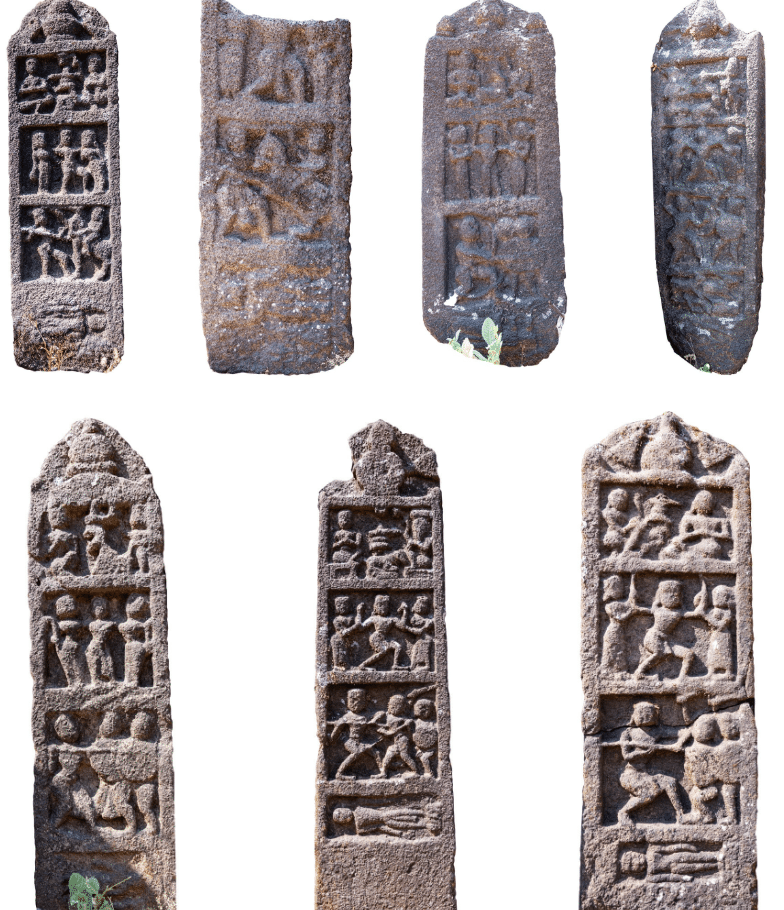
Sculptural embellishments on these hero stones can also give us more detail. Some hero stones have extremely elaborate Kalashas (pot or vessel) above the top panel which gives us an indication of their status in society, perhaps a member of a respected family or in some cases even a warrior with royal connections.
या वीर दगडांवरील शिल्पकला देखील आपल्याला अधिक तपशीलवार सांगू शकते. काही वीर दगडांच्या वरच्या पॅनेलवर अत्यंत विस्तृत कलश (भांडे किंवा भांडे) असतात जे आपल्याला समाजातील त्यांच्या स्थितीचे संकेत देतात, कदाचित ते एखाद्या आदरणीय कुटुंबातील सदस्य असतील किंवा काही प्रकरणांमध्ये राजेशाही संबंध असलेले योद्धे असतील.
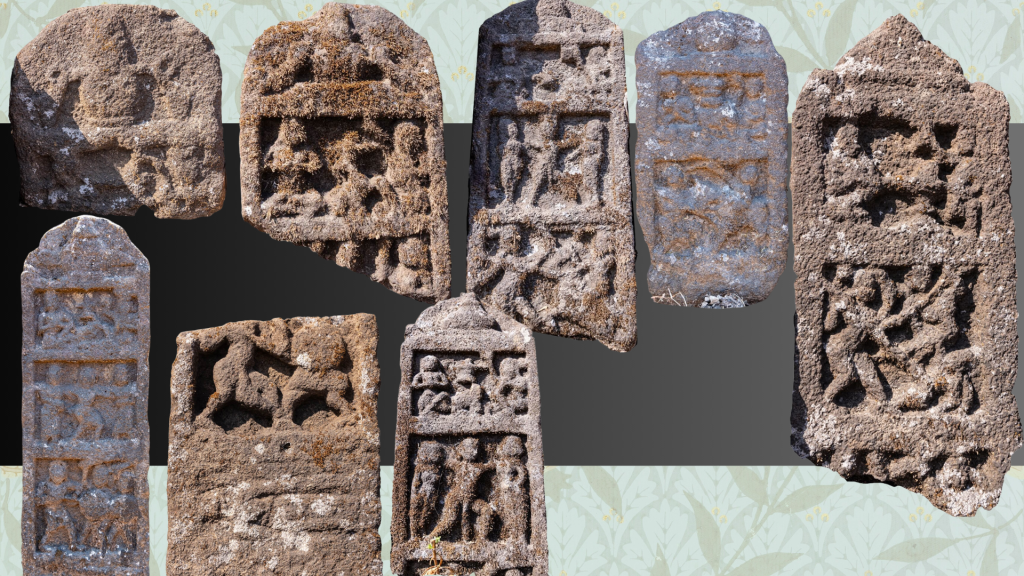
Likewise the form of the hero stone itself can add further colour. Whilst the vast majority of these memorials consist of a single slab carved on just one side, you can also find pairs of panels carved on one side of the stone, possibly indicating the death of relatives. This extends further to examples where the memorial consists of a square column with panels carved on all four sides. Of course we will never know if this implies the deaths of related people, or whether all the warriors died during a single incident, as the vast majority of these stones have no accompanying inscription.
त्याचप्रमाणे वीर दगडाचे स्वरूप देखील अधिक रंग भरू शकते. या स्मारकांपैकी बहुतेक स्मारकांमध्ये फक्त एका बाजूला कोरलेल्या एकाच पाटीचा समावेश असला तरी, तुम्हाला दगडाच्या एका बाजूला कोरलेल्या फलकांच्या जोड्या देखील आढळू शकतात, जे कदाचित नातेवाईकांच्या मृत्यूचे संकेत देतात. हे स्मारकात चौकोनी स्तंभ आहे ज्याच्या चारही बाजूंना कोरलेल्या फलकांचा समावेश आहे. अर्थात, आपल्याला कधीच कळणार नाही की याचा अर्थ संबंधित लोकांच्या मृत्यूचा आहे की सर्व योद्धे एकाच घटनेत मरण पावले, कारण यातील बहुतेक दगडांवर कोणताही शिलालेख नाही.
Sometimes the hero stones are accompanied by inscriptions narrating the act of the hero, the details of the battle and the warrior who fought the battle. In Maharashtra the existence of such inscriptions is extremely rare, and I have yet to find any examples at the sites I have thus far visited.
कधीकधी वीरांच्या दगडांसोबत वीराच्या कृतीचे, युद्धाचे तपशील आणि लढाईत लढणाऱ्या योद्ध्याचे वर्णन करणारे शिलालेख असतात. महाराष्ट्रात अशा शिलालेखांचे अस्तित्व अत्यंत दुर्मिळ आहे आणि मी आतापर्यंत ज्या ठिकाणी भेट दिली आहे तिथे मला अद्याप कोणतीही उदाहरणे सापडलेली नाहीत.

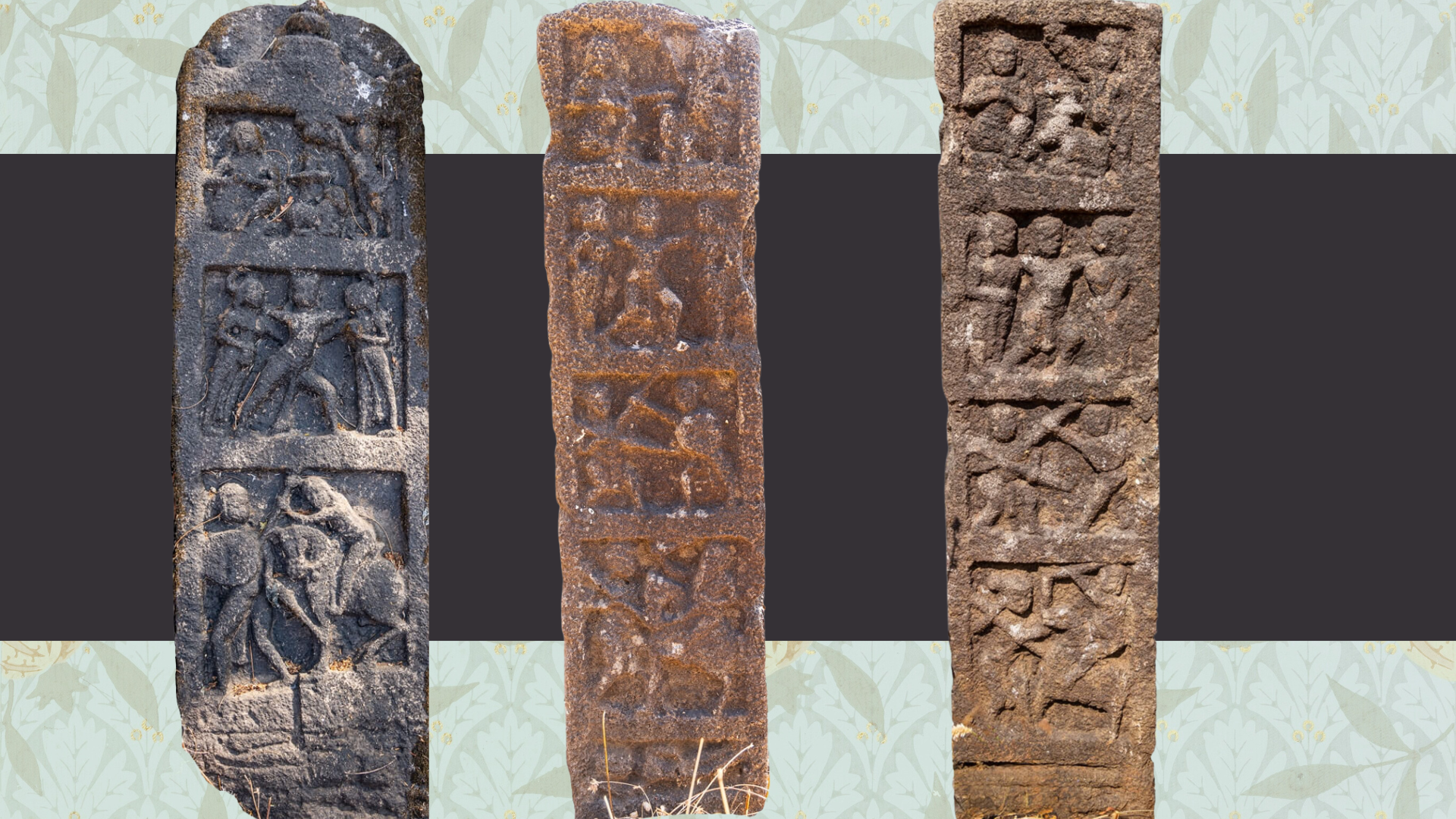
The stones themselves can be found in groups or in isolated settings, although often they are found near irrigation tanks or lakes outside a village. The scholarly tradition maintains that a hero stone was raised on the spot where the hero fell, where his remains were buried, or alternatively in his (or his relatives) native village. However, it is highly likely that many if not most of these stones have been displaced over the centuries as the landscape is reshaped (for farming, construction of new buildings or roads etc), and/or moved to protect them into museums or to local temples as we find here.
हे दगड स्वतः गटांमध्ये किंवा एकाकी ठिकाणी आढळू शकतात, जरी बहुतेकदा ते गावाबाहेरील सिंचन तलावांजवळ किंवा तलावांजवळ आढळतात. विद्वत्तापूर्ण परंपरेनुसार, ज्या ठिकाणी नायक पडला, जिथे त्याचे अवशेष पुरले गेले किंवा पर्यायाने त्याच्या (किंवा त्याच्या नातेवाईकांच्या) मूळ गावात एक वीर दगड उभारला गेला. तथापि, असे बहुधा आहे की यापैकी बरेच दगड शतकानुशतके विस्थापित झाले आहेत कारण भूदृश्य पुन्हा आकार घेत आहे (शेतीसाठी, नवीन इमारती किंवा रस्ते बांधण्यासाठी इ.), आणि/किंवा ते संरक्षित करण्यासाठी संग्रहालये किंवा स्थानिक मंदिरांमध्ये हलवले गेले आहेत जसे आपल्याला येथे आढळते.
The Sati Stones
Sati stones, poignant memorials erected to honor the widows of men who met their demise in battle, bear witness to a solemn and ancient Indian custom known as Sati Sahagamana, or self-immolation. Rooted in both grief and tradition, this practice involved a widow either climbing onto her husband’s funeral pyre or igniting one’s self shortly after his death. The belief held that such an act symbolized the closure of the marriage and bestowed merit upon the widow’s family, absolving them of sins. Considered the utmost demonstration of a wife’s devotion to her deceased husband, Sati was once a commonly practiced social tradition in certain rural parts of India.
युद्धात मृत्युमुखी पडलेल्या पुरुषांच्या विधवांच्या सन्मानार्थ उभारलेले सतीचे दगड, आत्मदहन म्हणून ओळखल्या जाणाऱ्या एका गंभीर आणि प्राचीन भारतीय प्रथेचे साक्षीदार आहेत. दुःख आणि परंपरा या दोन्हींमध्ये मूळ असलेली ही प्रथा विधवा तिच्या पतीच्या अंत्यसंस्काराच्या चितेवर चढत असे किंवा त्याच्या मृत्यूनंतर लगेचच स्वतःला पेटवत असे. असा विश्वास होता की असे कृत्य विवाह संपुष्टात येण्याचे प्रतीक आहे आणि विधवेच्या कुटुंबाला पुण्य देते, त्यांच्या पापांपासून मुक्त करते. पत्नीच्या तिच्या मृत पतीप्रती असलेल्या भक्तीचे सर्वोच्च प्रदर्शन मानले जाणारे, सती ही एकेकाळी भारतातील काही ग्रामीण भागात सामान्यतः पाळली जाणारी सामाजिक परंपरा होती.
Painting of a woman performing Sati, Murshidabad School, circa 1780.
In some respects Sati stones can be seen as an extension of hero stones, in that they memorialise the death of both the husband and wife on a single stelae. How the hero died (usually in battle) is often depicted in the third panel in much the same way as hero stones, and the lower-most bottom panel will sometimes show the horizontal dead hero with the wife seemingly joining the burning funeral pyre.
काही बाबतीत सती दगडांना वीर दगडांचा विस्तार म्हणून पाहिले जाऊ शकते, कारण ते एकाच शिलेवर पती-पत्नी दोघांच्याही मृत्यूचे स्मरण करतात. तिसऱ्या पॅनेलमध्ये नायक कसा मरण पावला (सामान्यतः युद्धात) बहुतेकदा वीर दगडांप्रमाणेच दर्शविला जातो आणि सर्वात खालच्या पॅनेलमध्ये कधीकधी आडवा मृत नायक दाखवला जातो ज्यामध्ये पत्नी जळत्या अंत्यसंस्काराच्या चितेत सामील होत असल्याचे दिसते.
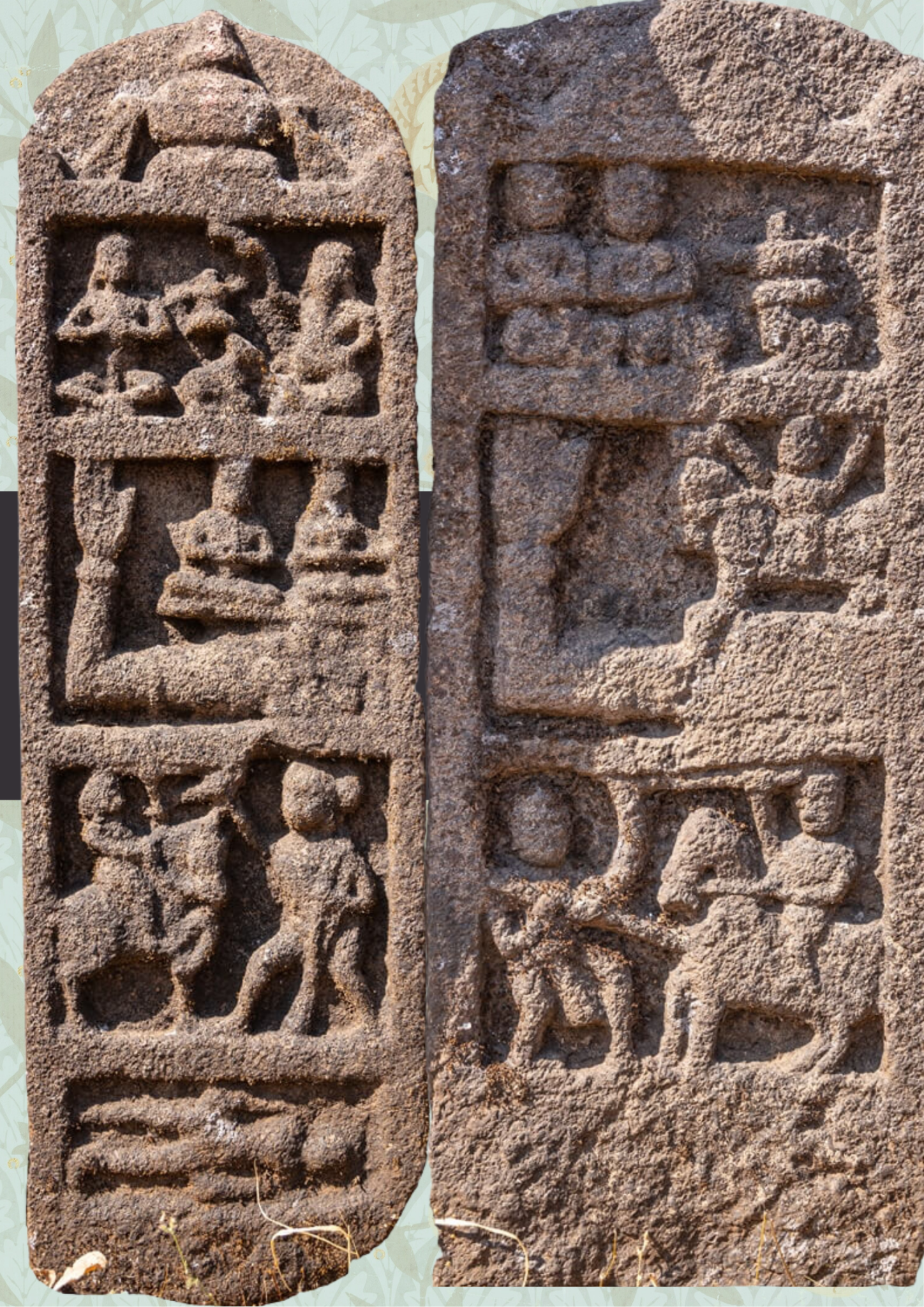

The term “Sati” is derived from the Sanskrit word “asti,” signifying purity or truth, encapsulating the revered status accorded to women who willingly embraced this ultimate sacrifice. These stones often depict the husband and wife, portraying the circumstances of the husband’s demise. Some depict vivid scenes, such as a fierce battle resulting in the hero’s death and the widow’s poignant act of devotion.
“सती” हा शब्द संस्कृत शब्द “अस्ति” पासून आला आहे, ज्याचा अर्थ शुद्धता किंवा सत्य आहे, जो स्वेच्छेने या अंतिम बलिदानाचा स्वीकार करणाऱ्या महिलांना देण्यात येणाऱ्या आदरणीय दर्जाचा समावेश करतो. हे दगड बहुतेकदा पती-पत्नीचे चित्रण करतात, पतीच्या मृत्युच्या परिस्थितीचे चित्रण करतात. काही दगड ज्वलंत दृश्ये दर्शवितात, जसे की वीराच्या मृत्यूमुळे होणारे भयंकर युद्ध आणि विधवेचे भक्तीचे मार्मिक कृत्य.
A recurring motif on these stones is the right arm sculpted as if emerging from the pillar, symbolizing the importance of the arm raised in blessing. Before immolation, the widow would bless the onlookers with her right hand, a gesture that continues to resonate in stone. Adorned with bangles, the raised hand is often bent at the elbow in an abhaya mudra, signifying fearlessness.
या दगडांवर वारंवार येणारा एक आकृतिबंध म्हणजे उजवा हात स्तंभातून बाहेर पडल्यासारखा कोरलेला आहे, जो आशीर्वाद देण्यासाठी उंचावलेल्या हाताचे महत्त्व दर्शवितो. दहन करण्यापूर्वी, विधवा तिच्या उजव्या हाताने पाहणाऱ्यांना आशीर्वाद देत असे, हा हावभाव दगडात प्रतिध्वनित होत राहतो. बांगड्यांनी सजवलेला, उंचावलेला हात बहुतेकदा अभय मुद्रेत कोपरावर वाकलेला असतो, जो निर्भयतेचे प्रतीक आहे.


The representation of bangles holds significant symbolism, as they traditionally indicate the married status of Hindu women. In the ritual of widowhood transition, women are compelled to break their bangles; however, the sati stone’s depiction suggests an eternal connection between the sati and her spouse, even beyond death. Other elements, such as the sun and the moon, signify the immortality of the sati, ensuring her fame persists as long as these celestial bodies endure.
बांगड्यांचे प्रतिनिधित्व हे एक महत्त्वाचे प्रतीकात्मक रूप आहे, कारण ते पारंपारिकपणे हिंदू महिलांच्या विवाहित स्थितीचे सूचक आहेत. विधवात्वाच्या संक्रमणाच्या विधीमध्ये, महिलांना त्यांच्या बांगड्या तोडण्यास भाग पाडले जाते; तथापि, सतीच्या दगडाचे चित्रण सती आणि तिच्या जोडीदारामधील, मृत्यूच्या पलीकडेही, एक शाश्वत संबंध दर्शवते. सूर्य आणि चंद्रासारखे इतर घटक सतीच्या अमरत्वाचे प्रतीक आहेत, ज्यामुळे तिची कीर्ती जोपर्यंत हे आकाशीय पिंड टिकून आहेत तोपर्यंत टिकून राहते.
Interestingly, some Sati stones portray two right arms, possibly indicating that the deceased husband had two wives, both of whom chose self-immolation.
While Sati was initially a voluntary act, over time, it transformed into a coerced practice. Widows who resisted were pressured to comply due to societal expectations that rendered them burdensome if they had no surviving children for support. The peak of the Sati practice occurred between the 15th and 18th centuries when, tragically, up to 1000 widows were burned alive annually in India and Nepal, with records indicating similar practices in Russia, Fiji, and Vietnam.
काही सती दगडांवर दोन उजव्या हातांचे चित्रण केले आहे, जे कदाचित मृत पतीला दोन बायका असल्याचे दर्शविते, ज्या दोघांनीही आत्मदहन करण्याचा पर्याय निवडला. सुरुवातीला सती ही एक स्वेच्छेने केलेली कृती होती, परंतु कालांतराने ती जबरदस्तीने करण्याच्या प्रथेत रूपांतरित झाली. ज्या विधवांना विरोध करायचा होता त्यांना सामाजिक अपेक्षांमुळे पालन करण्यास भाग पाडले जायचे कारण जर त्यांना आधार देण्यासाठी मुले नसतील तर ते ओझे वाटायचे. सती प्रथेचा शिखर १५ व्या आणि १८ व्या शतकादरम्यान घडला जेव्हा, दुर्दैवाने, भारत आणि नेपाळमध्ये दरवर्षी १००० पर्यंत विधवांना जिवंत जाळले जात असे, रशिया, फिजी आणि व्हिएतनाममध्ये अशाच पद्धतींचे रेकॉर्ड दर्शवितात.
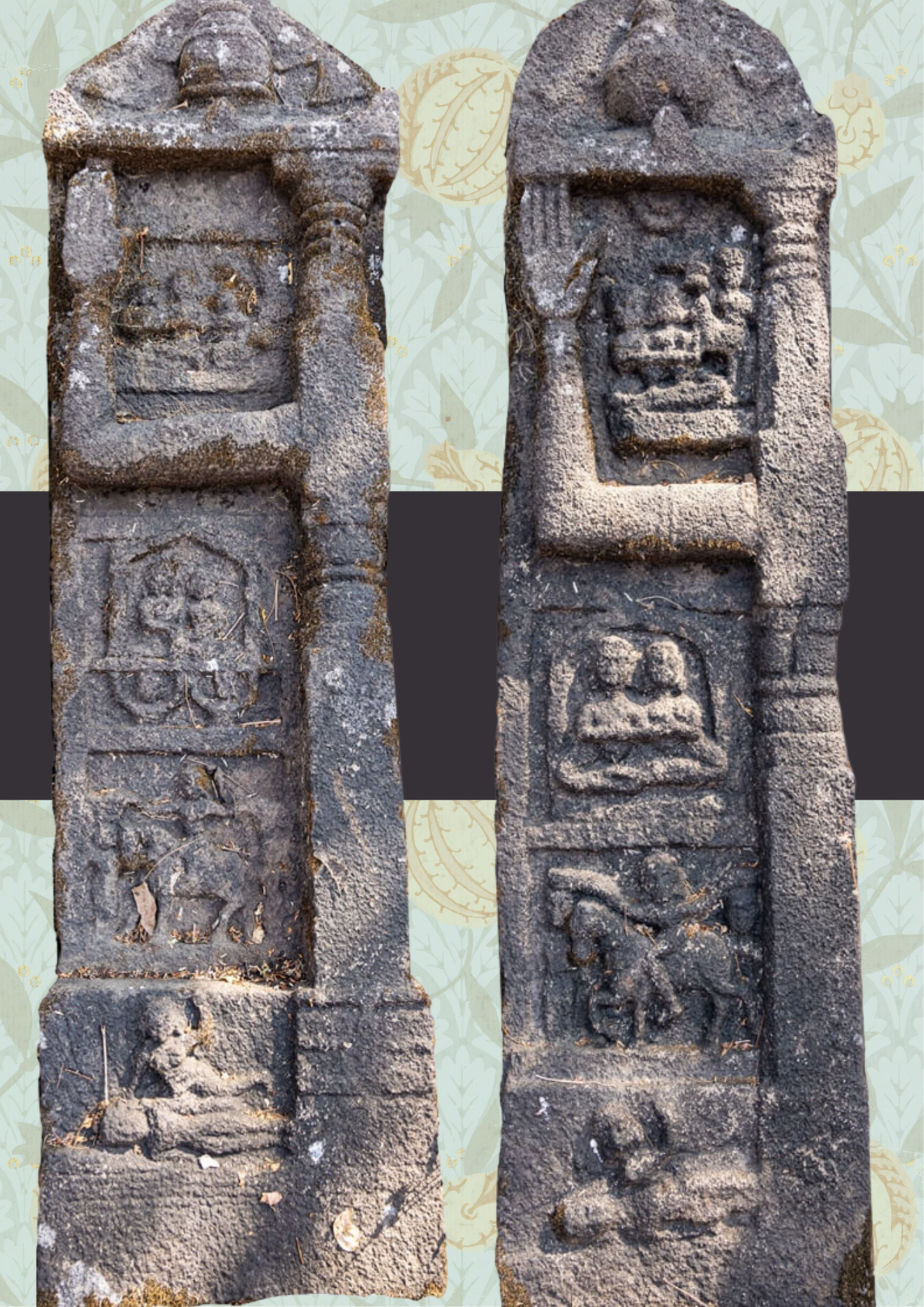
Note that on both these stones the wife is depicted joining the husband on the funeral pyre

In 1987, in the village of Deorala in Rajasthan, an 18-year-old married woman named Roop Kanwar was forced to become sati when her husband died after eight months of marriage. She refused. Consequently, a group of men from the village forcefully drugged and immolated her. Police investigated the case and those men were arrested. In light of this incident, the government created the Prevention of Sati Act, making it illegal to force or encourage a woman to commit sati, and anyone doing so would be punished by death. And yet, some widows still choose to become sati – at least four such cases were recorded between 2000 and 2015.
१९८७ मध्ये, राजस्थानमधील देवराला गावात, रूप कंवर नावाच्या १८ वर्षीय विवाहित महिलेला लग्नाच्या आठ महिन्यांनंतर तिचा पती वारला तेव्हा सती जाण्यास भाग पाडण्यात आले. तिने नकार दिला. परिणामी, गावातील काही पुरूषांनी तिला जबरदस्तीने नशा करून जाळून टाकले. पोलिसांनी या प्रकरणाची चौकशी केली आणि त्या पुरूषांना अटक करण्यात आली. या घटनेच्या पार्श्वभूमीवर, सरकारने सती जाळण्यास प्रतिबंधक कायदा तयार केला, ज्यामुळे एखाद्या महिलेला सती जाळण्यास भाग पाडणे किंवा प्रोत्साहित करणे बेकायदेशीर ठरले आणि असे करणाऱ्यांना मृत्युदंडाची शिक्षा दिली जात असे. आणि तरीही, काही विधवा अजूनही सती जाण्याचा पर्याय निवडतात – २००० ते २०१५ दरम्यान अशा किमान चार घटनांची नोंद झाली.







The Gadhegal Stone (Ass Curse Stone)
The Gadhegal represents a unique sculptural phenomenon primarily documented in Maharashtra and Goa, with a solitary instance reported in Gujarat. Its presence is closely associated with a specific historical period, ranging from the reign of the Shilahara dynasty to the Adilshahi, spanning the years 1012 CE to 1651 CE. These precise dates are derived from inscriptions found on the earliest and latest known dateable examples.
गढेगल हे शिल्पकलाकृतीतील एक अद्वितीय घटना आहे जी प्रामुख्याने महाराष्ट्र आणि गोव्यात नोंदवली गेली आहे, तर गुजरातमध्ये एकच उदाहरण आढळते. शिलाहार राजवंशाच्या कारकिर्दीपासून ते आदिलशाहीपर्यंत, इ.स. १०१२ ते १६५१ या काळात पसरलेल्या एका विशिष्ट ऐतिहासिक कालखंडाशी त्याची उपस्थिती जवळून संबंधित आहे. या अचूक तारखा सर्वात जुन्या आणि नवीनतम ज्ञात तारखेच्या उदाहरणांवर सापडलेल्या शिलालेखांवरून घेतल्या आहेत.
Characterized by large, flat, rectangular stone plaques or stelae, the gadhegals are typically embedded in the ground, standing upright, often with an inscription in the Devanagari script. The term “gadhegal” itself is derived from “gadhe,” meaning “donkey,” and “gal,” meaning “stone,” alluding to the lowermost panel’s sculptural depiction featuring a crouched human figure engaged in a peculiar act with a donkey. Another interpretation connects the name to a combination of “gadhe” (donkey) and “gaal” (swear word), resulting in the English equivalent “ass curse stone.”
मोठ्या, सपाट, आयताकृती दगडी पाट्या किंवा शिलालेखांनी वैशिष्ट्यीकृत, हे गाढेगळ सामान्यतः जमिनीत सरळ उभे असतात, ज्यावर देवनागरी लिपीत शिलालेख असतो. “गाढेगळ” हा शब्द स्वतः “गाढे” म्हणजे “गाढव” आणि “गाल” म्हणजे “दगड” या शब्दापासून आला आहे, जो सर्वात खालच्या पॅनेलच्या शिल्पकलेतील चित्रणाचा संदर्भ देतो ज्यामध्ये गाढवासोबत एका विचित्र कृतीत गुंतलेली एक मानवी आकृती आहे. आणखी एक अर्थ लावल्याने हे नाव “गाढे” (गाढव) आणि “गाल” (शपथ शब्द) यांच्या संयोजनाशी जोडले जाते, ज्यामुळे इंग्रजी समतुल्य “गाढव शाप दगड” बनतो.


